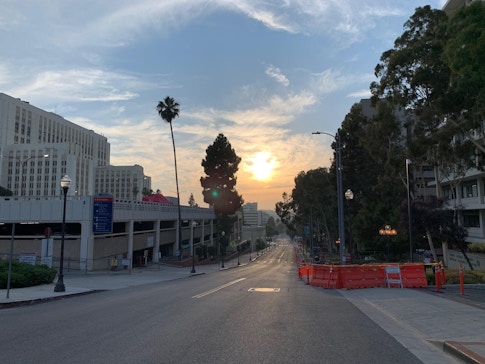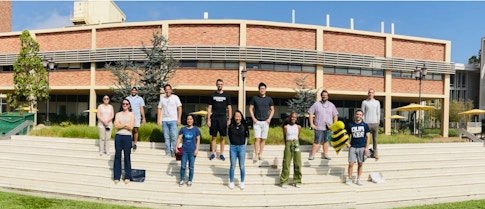
How Neuroscientists Are Adapting to the Ongoing Pandemic
In June 2020, Gerald Pao found himself driving up the California coast, bringing SARS-CoV-2 plasmids, carefully packed in dry ice, up to his collaborators in Los Angeles. At that point in the pandemic, shipping was basically impossible. So Pao took the situation — and plasmids — into his own hands.
Pao is a staff scientist at the Salk Institute, where he typically works on modeling neural dynamics and genetically engineering tissues to be more transparent. But early on in the pandemic, Pao realized that he could put his prior virology experience to use and started developing molecular tools to study the coronavirus. Now his plasmid is one of the most frequently used in SARS-CoV-2 research.
The pandemic has brought dramatic changes for almost everyone, and research labs have been no exception. For the past year and a half, most universities and research institutions have severely restricted who could physically enter a laboratory space. Individuals who cared for animals and those conducting research on SARS-CoV-2 were among the few who were allowed entry. Pao and his collaborator, senior research scientist Junko Ogawa, were often alone at the Salk. “At a certain point we were the only lab that was actually doing experiments,” Pao says. “Everybody else was in maintenance mode.”

Pao’s pandemic pivot is an extreme example, but almost every scientist has had to adapt their research focus, lab culture, or both. With restricted access to their labs, experimentalists faced a dramatic shift into new ways of being a researcher, and sometimes into new fields. Some have made the best of a bad situation, taking advantage of the forced pause to work their way through backlogs of data, to improve commonly used algorithms or to squeeze new insights from open datasets.
But the lack of casual interaction — a sort of special sauce in science whose benefits are hard to pin down — is taking its toll. Young researchers aren’t having the chance meetings that can fuel new ideas, broaden their networks and deepen their perspective on the practice of science. Even computational neuroscientists, accustomed to life in front of a computer, are feeling the effects. In isolation, they’re far away from the experimentalists who often inspire new dimensions as well as constraints for their models. Experiments are now resuming. But capacity limits and COVID concerns continue to keep labs emptier than usual, slowing the return of the culture of science.
New research directions
Early in the pandemic, some experimentalists remained hopeful, predicting that taking a break from data collection would give them a chance to reflect on the data they had and plan for the future. For experimentalists like Lisa Giocomo, a neuroscientist at Stanford University and an investigator with the Simons Collaboration on the Global Brain, this was a good stopgap measure. Her lab spent the first two months of lockdown spike sorting and analyzing a backlog of high-yield Neuropixels electrophysiology recordings. “Data analysis got us through the initial shock of the shelter-in-place portion of the pandemic,” Giocomo says. “It was definitely a way for folks to make progress, have something to work on and still feel a significant connection to their science.”
But as quarantine continued and most labs remained under strict restrictions, labs ran out of analyses to do and couldn’t conduct the needed follow-up experiments. “Just about everyone ran into a place where they needed to do more experiments,” Giocomo says. “Even those that wrote up entire papers during the pandemic definitely needed lab access to address reviewer comments.” And so science was stalled, unless researchers were willing to dramatically change direction.
Facing locked laboratory doors, some researchers chose to move their projects from the bench to the computer. In addition to working on SARS-CoV-2, Pao took on more computational projects. Working with an undergraduate student, he created an algorithm that allowed him to take neural activity and predict the type of behavior created by it. The project, which they posted to arXiv.org in June, relied on previously published datasets from other labs at the Salk Institute and the University of California, San Diego.
The combination of closed labs and open data inspired some researchers to tackle long-standing questions in their subfields. University of New Mexico neuroscientist Sam McKenzie spent some of the pandemic trying to understand how different brain regions interpret spatial signals from the hippocampus. Two published papers, one his own and one from a colleague in his lab, offered conflicting results about whether or not certain regions could read out hippocampal place cell activity. To address the inconsistency, McKenzie reanalyzed existing data — hosted in an online public resource by McKenzie’s postdoctoral adviser, György Buzsáki — to test whether the pattern of hippocampal activity, or just the amount of activity overall, best predicted how the rest of the brain reacts to hippocampal outputs.
By tapping into both papers’ datasets as well as four others, McKenzie was able to show that multiple regions in the striatum and cortex could indeed read out hippocampal signals, but that their ability to do so depended on the ongoing pattern of activity. McKenzie’s preliminary work inspired a colleague, Noam Nitzan, to similarly analyze the decoding ability of the plethora of brain regions included in datasets from the Allen Institute for Brain Science. Nitzan is also finding complex relationships between hippocampal output and brain state.
Similarly, University of Oxford doctoral student Emma Bluemke had planned her keystone thesis experiment to detect oxygen delivery using MRI for April 2020 — it didn’t happen. Instead, she decided to change gears. “I had a feeling COVID-19 was going to be longer than we were expecting at the time, so I realized I’d need to make a worthy thesis without any more experiments,” she says. She started her pivot by conducting an in-depth literature review, surveying more than 300 papers in her field and reanalyzing their data.
Soon, Bluemke realized that the data didn’t really fit the equation many researchers use to predict the way blood flow appears in an MRI. She adjusted the equation to make it more broadly applicable to other types of research questions and dramatically improved the model fits. “If I hadn’t been forced by COVID to stop doing my own experiments, I wouldn’t have discovered any of these things,” Bluemke says.
Other researchers shifted to projects that could be executed via remote data collection. Laura Grafe, a neuroscientist at Bryn Mawr College, studies the neurobiology of sex differences in stress and sleep in rodents. But it became impossible to do these studies with lab shutdowns. So Grafe shifted her work to humans, administering an online questionnaire to examine how the stress of COVID was affecting sleep. She is now collecting physiological data from Fitbits to help connect the dots between neurobiological mechanisms found in rodents to her new work in humans.
When unscripted interactions disappear
As a theorist, Brent Doiron, a neuroscientist at the University of Chicago and an SCGB investigator, initially didn’t worry deeply about the pause on data collection. He pivoted toward projects where he could generate his own in silico data. But over time, he recognized that the shift had a downside — pulling him away from experimentalists. “I’m basically importing ideas from other fields and then not marrying them with computational neuroscience as much as I should,” Doiron says. “Maybe that’ll be good — I’m not sure. My gut says no, though.”
Doiron is also starting to worry about how the shutdown is affecting the next generation of theorists, particularly in terms of collaboration with experimentalists. “I think we’re really at a point where the lack of interaction is starting to take its toll,” he says.
Doiron isn’t alone. Many researchers worry about the cultural shifts the pandemic has brought on, both within their labs and in the field at large. Rather than spontaneously meeting others at the proverbial watercooler (more likely an espresso machine), lab members have to go out of their way to set up virtual meetings with one another.

“I think the group carrying the biggest burden are the younger people, because they haven’t had the chance to go to conferences,” says Anne Churchland, a neuroscientist at the University of California, Los Angeles and an SCGB investigator. “If you’re new to the field and have a bunch of people come to your poster or you go to a summer course and spend all night talking about the visual system and why we have orientation columns, that’s hugely valuable. And they’re missing out on that.”
The computational neurobiology group at the Salk Institute, led by Terry Sejnowski, hosted a daily tea for their lab members and others, including Pao, before the shutdowns started. They tried to reproduce this in the virtual setting, but it didn’t quite work. “You can instantly see the difference in the type of discussions that you generate,” Pao says.
Doiron recalls informal coffee chats he had as a postdoc with then lab mate Eric Shea-Brown. “It wasn’t just after-work beers or ‘How’d the Steelers do?’ conversations — it was more serious conversations, and those trainee-trainee interactions are no longer happening.”
For Doiron, these interactions aren’t just nice; they’re necessary. Gathering a group of thinkers in a room is crucial to navigating what he calls the wild west of computational neuroscience. “In my experience, my big advances have all come through unscripted interactions,” he says. “It’s very rare that I just went to a coffee shop, sat deeply for hours and then walked out with a new amazing way to look at things, without the back-and-forth.”
Doiron is worried that the pandemic is leaving trainees with a myopic view of the scientific endeavor — as a linear, isolated stream of projects and corresponding papers — but he is caught between encouraging trainees to come back to the lab and respecting their personal lives and COVID concerns.
Churchland points out that it can also be harder to have the tough, more emotional conversations over Zoom. “I think one of the big things that in-person interactions support is the ability to smooth the waters a bit,” she says. “Stuff comes up — you don’t agree about something, you’re not on the same page about something — and you might stew over it until you see them again.” At an in-person conference you might bump into that person in the coffee line the next day and reconnect, but that kind of serendipitous meeting is less likely online.
Virtual courses and conferences, which in many ways have been a positive outcome of the pandemic, have tried to engineer the types of interactions common to in-person events using various online tools. Neuromatch Academy has relied heavily on Discord, an online messaging system. (For more on Neuromatch Academy, see “The Self-Organized Movement to Create an Inclusive Computational Neuroscience School.”) Some labs and conferences have also tried platforms such as Gather, an interactive space with tiny avatars. The SCGB hosts a virtual postdoc seminar series, which includes time for attendees to talk informally with the speaker. Though these tools help fill some of the void, they have yet to approach the type of in-person interactions that commonly happen at conferences or in the lab.
As labs continue to invite members back and seminars and conferences are planned for 2022, signs of normalcy are creeping in. But everything is tinged with uncertainty. Some organizations are returning to in-person events, including the Society for Neuroscience, which is planning both in-person and virtual versions of their annual meeting for the fall. Those who feel safe enough to travel may benefit, while others watching from afar may feel further isolated. Chance gatherings around posters or the coffee machine may be the last to return.


